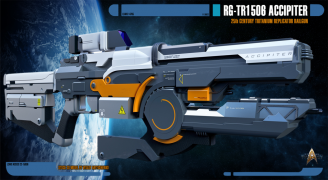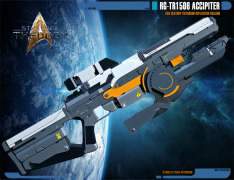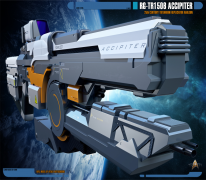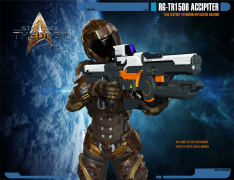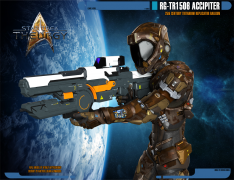The Accipiter: Difference between revisions
From Star Trek: Theurgy Wiki
Auctor Lucan (talk | contribs) No edit summary |
Auctor Lucan (talk | contribs) |
||
| (4 intermediate revisions by the same user not shown) | |||
| Line 63: | Line 63: | ||
== Usage History== | == Usage History== | ||
[[The Accipiter]] was deployed for usage | [[The Accipiter|The Accipiter]] was deployed for usage after the ''Theurgy'' acquired them from the ''[[USS Calamity]]'' at these times: | ||
The | * The first time was when [[Security]] boarded the [[Black Opal]] facility, the boarding team meeting heavy [[Romulan]] resistance on-site. | ||
The second time was when [[the Devoted]] tried to claim command of the Theurgy, and [[Varder Ridun]] was granted usage of an Accipiter in order to neutralise a [[Devoted]] flying a worker bee without igniting the sirillium gas clouds that encompassed the ''Theurgy''. | * The second time was at the end of the [[Starbase 84]] mission, where one of the boarding teams brought one to ensure that they could gain access to the main reactor. It was then used with its concussion mode successfully. | ||
* The third time was when [[the Devoted]] tried to claim command of the ''Theurgy'', and [[Varder Ridun]] was granted usage of an Accipiter in order to neutralise a [[Devoted]] flying a worker bee without igniting the sirillium gas clouds that encompassed the ''Theurgy''. | |||
* The fourth time was when [[Task Force Archeron]] threatened to destroy the Helmet in the [[Azure Nebula]], and [[Ryuan Sel]] - as the Acting Chief of [[Security]] of the Vector - brought one out of storage. While mindful to not use deadly force, the display of [[the Accipiter]] was effective in terms of intimidation as she sided with Commander Dewitt on the Main Bridge. | |||
* The fifth time, [[Adam Kingston]] used it against [[Borg]] drones during the [[Battle of the Apertures]]. | |||
==Gallery== | ==Gallery== | ||
Latest revision as of 13:08, 8 June 2020
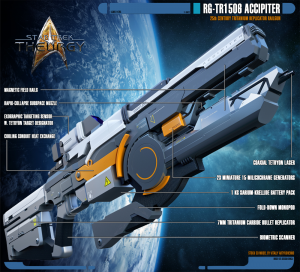
| |
| Model: | RG-TR1506 Accipiter |
| Mass (loaded): | 7kg (1 kg sarium-krellide battery pack) |
| Total Length: | 0.97m |
| Battery Pack Endurance: | ~2 minutes' sustained fire at maximum rate |
| Railgun Muzzle Velocity: | 5500m/s |
| Effective Range: | 8km |
| Sighting: | Exographic targeting sensor, tetryon target designator, backup iron-sights |
| Safety: | Fingerprint scanner, biometric scanner in grip; retinal scanner in scope |
| Rifle 3D Model: | Vitaliy Artyushenko at ARTYuSTUDIO |
| Exosuit 3D Model: | Auctor Lucan & Omardex |
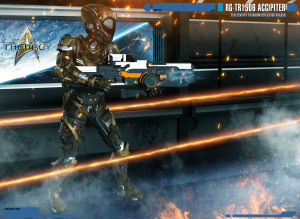
| |
The RG-TR1506 Accipiter was an advanced projectile rifle that hailed from early 25th century technology. 5 examples of these weapons were recovered from the cockpits of destroyed Reavers after the last battle between the USS Calamity and the USS Theurgy in early 2381. They were not distributed on the Theurgy without consent of two members of the senior staff.
The first Accipiter was recovered from the Reaver that Evelyn Rawley landed in the hangar after the escape from Theta Eridani IV, but due to its biometric safety measures it was useless until Thea could derive the code that restored the weapons to their factory settings. Obviously, the Accipiter was meant as a heavy support weapon and not TacCONN pilot standard issue, but for the holograms in the Reavers, the weight and bulk of these weapons were not a disadvantage, and so had been issued to the pilots in order to overwhelm any opposition they might have encountered on the ground.
Technical Specifications
The Accipiter featured a modified railgun system as its method of projectile propulsion. A replicator capable of high-volume energy-to-matter constitution created a 7mm tritanium carbide bullet, which was fed into a rapid-collapse subspace field produced by paired miniature 15-milicochrane generators. The bullet, virtually weightless inside the subspace field, was accelerated by a magnetic field and was capable of reaching 5.5km/s. Once it left the barrel, the subspace jacket around the projectile would dissipate and the resulting change in mass would add considerable impact energy to the bullet due to conservation of momentum, without rendering the weapon nonviable because of excessive recoil.
In theory, the weapon was capable of 1500 rounds-per-minute in sustained fire, though this would overheat the weapon in short order and heavily ionise any surrounding atmosphere - both of which could endanger the user and any surrounding personnel. There were regenerative cooling conduits that captured some of the wasted heat energy and fed it back to the power cell, but they were designed to fail before the rails could get hot enough to carbonise, as a fail-safe.
An onboard computer aided targeting by collating sensor data and the user's input in order to automatically adjust for relevant atmospheric conditions, intervening obstacles, and target movement, and could be set to utilise the firing pattern that produced the best chance of a successful hit on any given trigger-pull if the user so chose. A coaxial tetryon laser was used to 'paint' targets both for Accipiter acquisition and potential external tracking methods.
Methods Of Use
The rifle could be fired in a single-shot pattern or in a variety of programmed bursts that could fire a desired number of projectiles in streams of up to one second. Full-auto sustained fire was possible, but recommended only for limited periods and with adequate time to allow the weapon to cool. Generally, the most common patterns included but were not limited to:
- Single shot
- 3-round burst
- 10-round burst
Given the weapon's size and weight, it was not suited to close-quarters fighting and it was highly recommended that any designated user also be equipped with at least a sidearm in case of attack.
In testing it was found that the weapon could be fired 'dry' - that is, without a projectile launch. In these instances the subspace jacket would be formed and fired as normal, though only in single-shot, and the concussive energy could be used to break up debris or shove objects out of the way that might otherwise be too massive for the user to move on their own. However, this stressed the field generators and risked warping the gun rails, and so was not recommended during normal use. User discretion applied.
The combination of the weapon's tetryon designator and exographic scope meant that targets could be tracked and engaged even after line of sight had been broken, as long as the user could successfully paint the target with the tetryon beam before loss of contact. In addition, the tetryon silhouette would linger for some time and so could be used for reconnaissance as well as target destruction.
Usage History
The Accipiter was deployed for usage after the Theurgy acquired them from the USS Calamity at these times:
- The first time was when Security boarded the Black Opal facility, the boarding team meeting heavy Romulan resistance on-site.
- The second time was at the end of the Starbase 84 mission, where one of the boarding teams brought one to ensure that they could gain access to the main reactor. It was then used with its concussion mode successfully.
- The third time was when the Devoted tried to claim command of the Theurgy, and Varder Ridun was granted usage of an Accipiter in order to neutralise a Devoted flying a worker bee without igniting the sirillium gas clouds that encompassed the Theurgy.
- The fourth time was when Task Force Archeron threatened to destroy the Helmet in the Azure Nebula, and Ryuan Sel - as the Acting Chief of Security of the Vector - brought one out of storage. While mindful to not use deadly force, the display of the Accipiter was effective in terms of intimidation as she sided with Commander Dewitt on the Main Bridge.
- The fifth time, Adam Kingston used it against Borg drones during the Battle of the Apertures.
